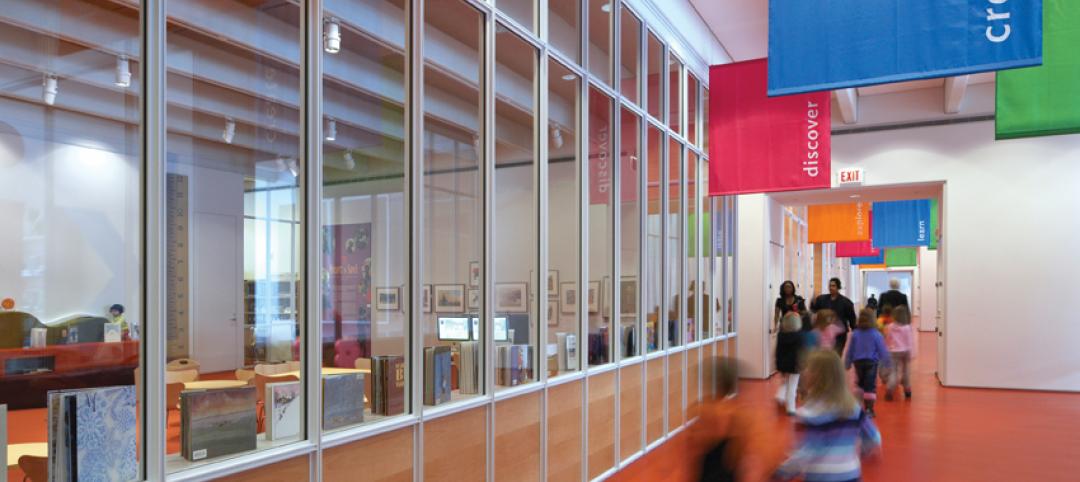New York may be home to more architectural landmarks than any city in the U.S., so when renowned architect Bjarke Ingels was commissioned by Durst Fetner to design a new apartment building along the city’s Hudson River, he chose to make a splash.
The result is VIA 57 West, an audacious, shape-shifting structure that appears as a soaring 467-foot spire when seen from the city-side of the building and a glittering metal-clad pyramid when viewed from the river.
Featuring a hybrid design that unites the traditional looks of a courtyard-block-style apartment complex and a towering Manhattan high-rise, VIA 57 West creates a striking profile on the New York city skyline and satisfies Ingels’ desire to connect residents to the outside world. To achieve that objective, the architect incorporated a variety of components, including a generous courtyard that punctures the center of the façade, open terraces that perforate the glittering metal curtain wall and oversized bay windows strategically positioned to brighten each of the building’s 709 apartments.
Utilizing Solarban® 70XL glass by Vitro Glass, the floor-to-ceiling windows in VIA 57 West contribute to an integrated energy management program that incorporates a highly efficient mechanical system, occupancy sensors for lighting and a hybrid water source heat pump system.
Carlos Amin, vice president of sales for Tecnoglass, said his company fabricated 5,000 window units from Solarban® 70XL glass in an array of shapes and sizes for the project, which he called one of the most complex he had ever worked on.
“The building faces west, so the architect was intent on specifying a product with a high solar heat gain coefficient,” he explained. “He also wanted a glass with good transparency to preserve the views.”
Formulated with the industry’s first triple-silver coating, Solarban® 70XL glass has a solar heat gain coefficient (SHGC) of 0.27 and a visible light transmittance of 64 percent in a standard 1-inch insulating glass unit. That configuration, which was specified for VIA 57 West, enables window units to block more than 70 percent of the ambient solar energy from entering the building, reducing demand for air-conditioning in the spring and summer, and enhancing the comfort and views of building occupants throughout the year.
As a glass and metal fabricator, Tecnoglass served as part of an integrated team of high-end contractors involved in meeting the building’s complex design demands. Working together, Tecnoglass, ENCLOS, Techniform and Bunting Architectural Metals fabricated, assembled and installed more than 350,000 square-feet of curtain wall; a 110,000-square-foot stainless steel slope wall; 1,200 stainless steel cladding components and 50,000 square-feet of glass-fiber reinforced concrete to create a 515,200-square-foot building envelope.
Since opening in 2016, VIA 57 West has gained numerous accolades for both its design and environmental performance. Even more important, it has added a gleaming new inhabitant to New York’s register of famous architecture while providing an oasis of comfort and sustainability to more than 700 residents and their families.
To learn more about Solarban® 70XL glass and other high-performance glass products by Vitro Glass, visit www.vitroglazings.com.
Related Stories
| Mar 29, 2011
Chicago’s Willis Tower to become a vertical solar farm
Chicago’s iconic Willis Tower (formerly the Sears Tower) is set to become a massive solar electric plant with the installation of a pilot solar electric glass project.
| Feb 11, 2011
Four Products That Stand Up to Hurricanes
What do a panelized wall system, a newly developed roof hatch, spray polyurethane foam, and a custom-made curtain wall have in common? They’ve been extensively researched and tested for their ability to take abuse from the likes of Hurricane Katrina.
| Feb 10, 2011
7 Things to Know About Impact Glazing and Fire-rated Glass
Back-to-basics answers to seven common questions about impact glazing and fire-rated glass.
| Feb 7, 2011
President Obama cites PPG glass, coatings in Penn State speech
President Barack Obama yesterday acknowledged PPG Industries as a leader in the development of high-performance glass and coatings for energy-efficient buildings during a visit to Penn State University that kicked off the U.S. government’s “Better Buildings Initiative.’
| Jan 21, 2011
Virginia community college completes LEED Silver science building
The new 60,000-sf science building at John Tyler Community College in Midlothian, Va., just earned LEED Silver, the first facility in the Commonwealth’s community college system to earn this recognition. The facility, designed by Burt Hill with Gilbane Building Co. as construction manager, houses an entire floor of laboratory classrooms, plus a new library, student lounge, and bookstore.
| Jan 21, 2011
Music festival’s new home showcases scenic setting
Epstein Joslin Architects, Cambridge, Mass., designed the Shalin Liu Performance Center in Rockport, Mass., to showcase the Rockport Chamber Music Festival, as well at the site’s ocean views.
| Dec 17, 2010
Subway entrance designed to exude Hollywood charm
The Hollywood/Vine Metro portal and public plaza in Los Angeles provides an entrance to the Red Line subway and the W Hollywood Hotel. Local architect Rios Clementi Hale Studio designed the portal and plaza to flow with the landmark theaters and plazas that surround it.
| Nov 16, 2010
NFRC approves technical procedures for attachment product ratings
The NFRC Board of Directors has approved technical procedures for the development of U-factor, solar heat gain coefficient (SHGC), and visible transmittance (VT) ratings for co-planar interior and exterior attachment products. The new procedures, approved by unanimous voice vote last week at NFRC’s Fall Membership Meeting in San Francisco, will add co-planar attachments such as blinds and shades to the group’s existing portfolio of windows, doors, skylights, curtain walls, and window film.












